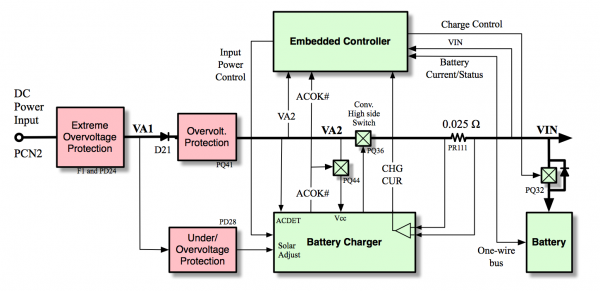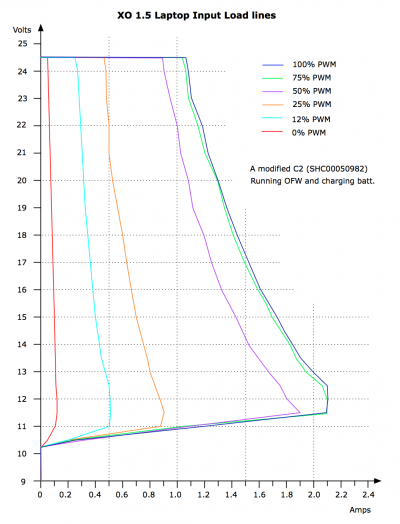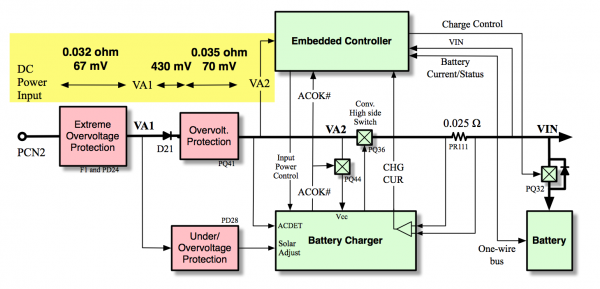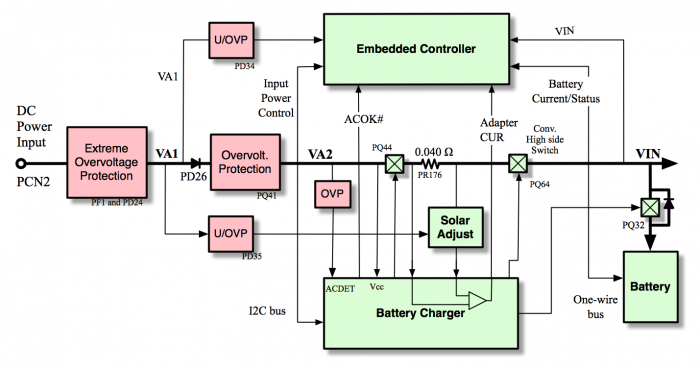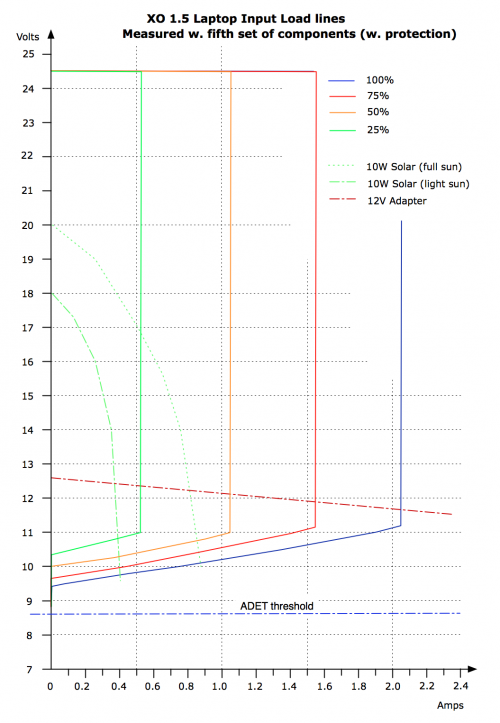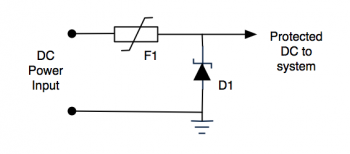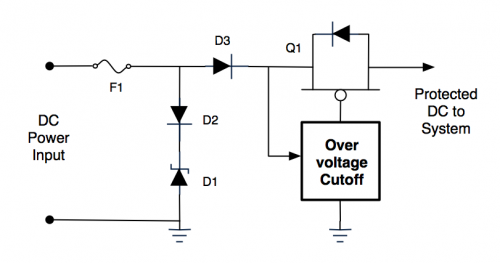XO DC Input Details
This page describes the XO DC Input circuit (requirements) in detail.
Introduction
The DC power input circuit on the XO laptop is unique. It is designed to accept a power from a wide range of input voltages (11 to 24V), protect itself from harm by a larger range of input voltages (-40 to 40V), and is also designed to seek the maximum power point of a solar input device.
Models
This is a description of the original DC input power circuit used in the XO-1.5 production models (C2/C3), as well as the new DC input power circuit introduced with the C4 production model.
The original DC power input circuit (based on a Fujitsu MB39A129) is almost identical to that used in the XO-1 laptops. The difference was the addition of software control over the input power limit in 1.5, allowing MPPT algorithms for solar power input. The input protection circuitry was the same.
The battery charge controller used in the new DC input power circuit (an Intersil ISL9519) is capable of supporting a single battery cell, and operating down to +5V input (although not in the XO-1.5 C4!) It is planned to continue using it in XO-1.75 (w. two cells) and XO-3.
Original Circuit
The original circuit provides the MPPT algorithm running on the Embedded Controller the following values:
- Input Voltage (VA2)
- Output Current from the battery charger, which is the sum of the system current and the battery current
- Output Voltage (VIN), equivalent to the battery voltage.
- Battery Voltage and Current, obtained via one-wire from the battery gas gauge
Hardware imposes a shape on the DC input impedance as shown in the following diagram. In particular, a maximum input power is specified (not a maximum input current) and the maximum input power decreases drastically as the input voltage drops below 11V.
The maximum input power may be modified under software control as shown by the 25%, 50%, and 75% curves. The precision varies but roughly 32 power steps are available.
Squeal
In order to operate with solar cells, the original circuit on XO-1 had a circuit that, starting a particular voltage, quickly cut the current input by the laptop back to zero. This means that even if a solar cell is undersized and underlit, it might provide a few milliwatts at 10.5V (with MPPT, we dynamically change the impedance to get more milliwatts at 14-16V). The particular voltage at which this circuit triggers and drops the current is set by a pair of resistors, a voltage source in the charger IC, and the parameters of a transistor. This current drop is seen at the bottom of the above input impedance graph for an XO-1.5 C3 laptop.
Key to the operation of this circuit (and preventing oscillation) is that the DC charger detect DC input and operate to a voltage below that at which the charger stops accepting current from the input. It is on, but we are telling it to supply no current to the laptop. This is set by a separate pair of resistors, and a separate voltage threshold in the charger.
Fast forward part of a year, and a completely new hardware team was finishing up testing when they realize that the laptop powers itself off if the battery is low and a DC adapter is plugged in (#2182). The fix seems innocuous, but it inadvertently added a 0.35V difference between the "DC input voltage" sensed by the two circuits (and in the wrong direction). This greatly increased the probability of oscillation when using solar cells.
The solution to both problems is to spread the two voltage thresholds farther apart. This was tested on real hardware today, and it does eliminate any squealing when the laptop is powered by a completely under-powered/under-illuminated solar panel. At the same time, it is possible for the EC firmware to detect this squeal (rapid turn-on/off of the battery charger) and use it as an indicator that input power needs to be reduced. Due to the next problem (voltage drop on the EC voltage sense), it turns out to be the most reliable way of detecting this condition!
Voltage Drop
A critical flaw in the design has finally been identified. The input voltage sensed by the EC is sensitive to the power drawn by the system --- up to 0.55 V of drop occurs as the input current increases from 0 to 2A ! The net effect of this is that voltages measured by the EC at the DC input are not accurate for use in an MPPT algorithm.
New Circuit
A new battery charger circuit was phased into production in the spring of 2011. This circuit provides the MPPT algorithm running on the Embedded_controller the following values:
- Input Voltage (VA1)
- Input Current to the battery charger
- Output Voltage (VIN), equivalent to the battery voltage.
- Battery Voltage and Current, obtained via one-wire from the battery gas gauge
The new battery charger (an Intersil ISL9519) requires additional circuitry to decrease the maximum input power as the input voltage drops below 11V. It was decided to attempt to control the maximum input power at higher input voltages through EC firmware. That is not shown in the following input impedance diagram:
Input Protection
The input protection circuit has four functions:
- When the voltage of the external power source is within the operating range of the laptop (9-24V), power should be transmitted with minimal loss to the battery charger.
- In the event of input voltages outside of the operating range, the laptop motherboard is disconnected from the external power source. The connection is restored when the applied voltage returns to an acceptable voltage.
- In the event of egregious input voltages (less than -40V or greater than 40V), the laptop motherboard is permanently disconnected from the external power source. After such an overvoltage, up to three components on the motherboard may need repair, but outside of protective circuitry (fuse and diodes) the motherboard should be unharmed.
- In the event of catastrophic failure of the motherboard, it prevents an excess of current from being drawn from an external power source. Repair of the motherboard will be needed.
Simple Approach
The simplest approach uses a resettable fuse (polyfuse), F1, with a zener diode, D1, tripping the fuse in the case of negative voltage or overvoltage.
The problem with this approach is that surface-mountable resettable fuse technology does not work well at higher temperatures and currents.
